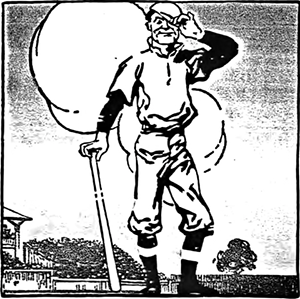Worcester Trivia Tidbit
Ernest Lawrence Thayer and ‘Casey at the Bat’

Ernest Lawrence Thayer was born on August 14, 1863, in Lawrence, Massachusetts, but he spent his formative years in Worcester, where his family lived on Chatham Street. He graduated with a bachelor’s in philosophy from Harvard University in 1885, where he was a member of the Hasty Pudding Club and edited the Harvard Lampoon.
At Harvard, Thayer met William Randolph Hearst, who would later run the San Francisco Examiner and hire Thayer to write a humorous column for the newspaper. On June 3, 1883, Thayer published “Casey at the Bat” under the pen name Phin. The poem gained popularity after the performer William DeWolf Hopper incorporated a recitation of it into his theatrical and radio performances.
The mock-heroic poem tells the story of a baseball team from the fictional town of Mudville who are losing by two runs in the last inning. Both the team and its fans, a crowd of 5,000, believe that they can win if Casey, Mudville’s star player, gets to bat. (Spoiler alert: He gets to bat, but he strikes out.)
Read the poemA month after the poem was published, it was reprinted as “Kelly at the Bat” in the New York Sporting Times. Aside from omitting the first five verses, the only changes from the original are substitutions of Kelly for Casey — and Boston for Mudville. King Kelly, then of the Boston Beaneaters, was one of baseball’s biggest stars at the time. (“There is no joy in Boston; mighty Kelly has struck out.” The Boston–New York baseball rivalry certainly goes back a long way.)

While it is considered to be baseball’s first poem, it is not Worcester’s only baseball “first.”
- The first perfect game was pitched here in 1880.
- The first doubleheader was played here in 1882 when Worcester was in the National League.
- The first sportswriter to go from covering a major league team to managing it was Freeman Brown of the Telegram, also in 1882 (Brown’s Worcesters went 9–32 with him at the helm).
- Hall of Fame manager Casey Stengel managed his first professional game here in 1925.
Learn more about Worcester’s connection with the poem: Baseball, poetry and Worcester: Recalling the city’s ties to ‘Casey at the Bat’ (Worcester Telegram & Gazette, June 3, 2013)
During the mid-1890s, Thayer contributed several other comic poems for The New York Journal (also a Hearst paper), and then began overseeing his family’s mills in Worcester full time. He relocated to Santa Barbara in 1912, where he married Rosalind Buel Hammett and retired. He died in 1940, seven days after his 77th birthday.


